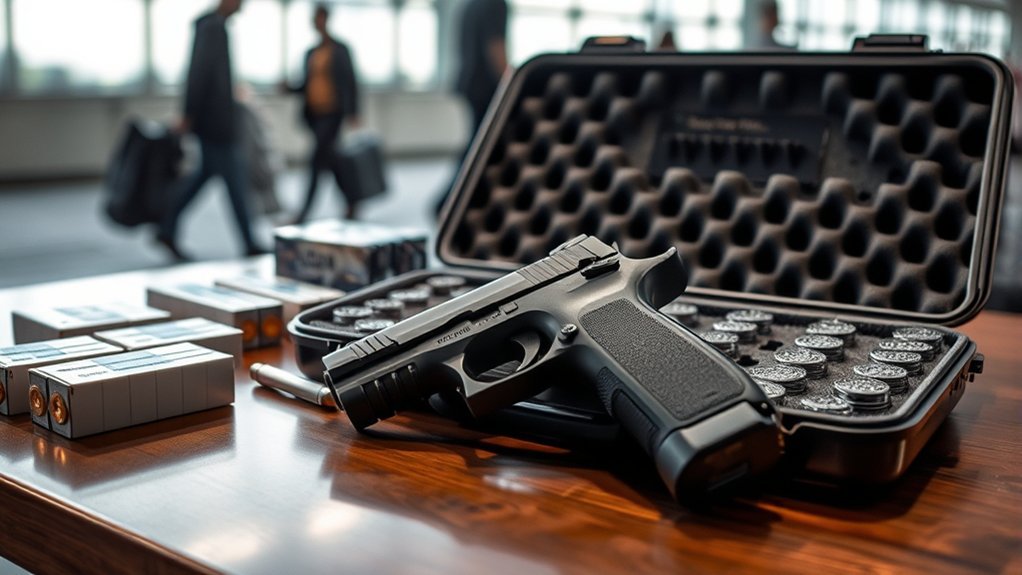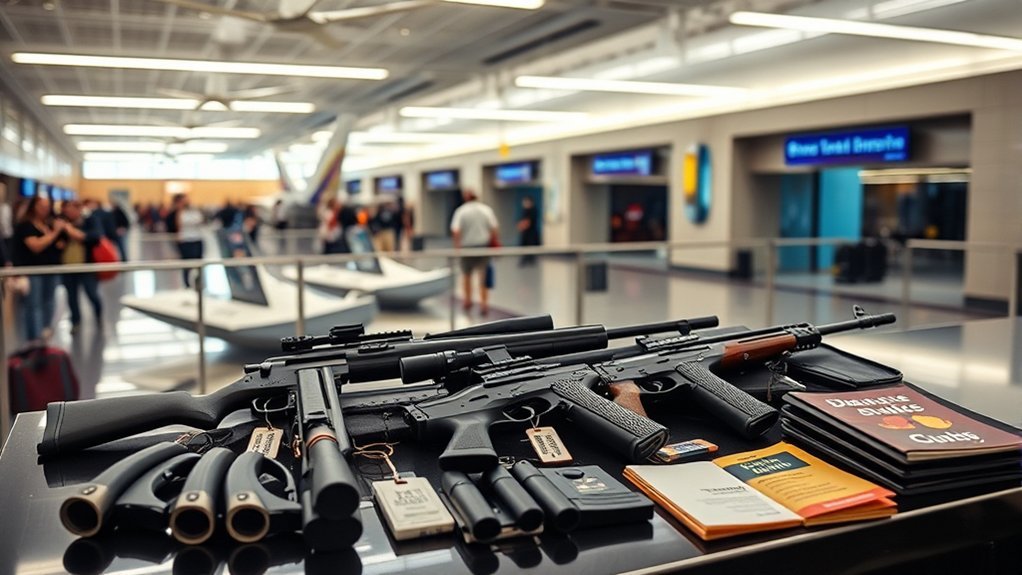When you’re planning to fly with firearms, understanding the rules is vital for a hassle-free journey. You need to guarantee your firearm is unloaded and stored in a locked hard-sided container, only in checked baggage. It’s not just about packing correctly; you must also navigate airport procedures and local laws that can vary greatly. Are you prepared to meet these requirements while avoiding potential pitfalls? Let’s break down the essential steps you’ll need to follow.
TSA Regulations for Traveling With Firearms
When you’re planning to travel with firearms, it’s important to understand the TSA regulations that govern their transport. First, verify your firearm is unloaded and stored in a locked hard-sided container for checked baggage. Carrying a weapon onto a plane is strictly prohibited. At the airline check-in counter, you’ll need to declare your firearm and sign a declaration card confirming it’s unloaded. Remember, only firearms and ammunition are allowed in checked baggage; no firearms can be in your carry-on luggage. When packing ammunition, use the original manufacturer packaging or designated containers, and adhere to the limit of 11 pounds (5 kgs) per customer. Always comply with TSA regulations as well as local, state, and international firearm regulations.
Preparing Your Firearm and Ammunition

To guarantee a smooth travel experience with your firearm and ammunition, start by confirming that your firearm is unloaded and packed securely in a hard-sided, lockable case. Remember, your firearm must be stored in checked bags, as carry-on is not allowed. Use a chamber flag to indicate it’s non-functional, and double-check all components for TSA compliance. Store ammunition in its original packaging or a suitable container, keeping within the 11-pound limit per traveler.
| Item | Packing Requirement |
|---|---|
| Firearm | Unloaded, hard-sided, lockable case |
| Ammunition | Original packaging or designed containers |
| Declaration | Sign a Firearm Declaration at check-in |
Familiarize yourself with your airline’s specific policies for traveling with firearms.
Declaring Your Firearm at the Airport

After securely packing your firearm and ammunition, the next step involves declaring your firearm at the airport. Upon arrival, head to the Special Services counter to declare your firearm before checking in your luggage. Calmly inform the bag check agent that you’re traveling with a firearm, and be ready to demonstrate that it’s properly stored and unloaded. You’ll need to sign and date a firearms declaration card, which will be placed near your firearm’s case during screening. Verify your firearm is in a locked hard-sided case, as TSA agents will inspect it to confirm it’s unloaded. Keep the declaration card secured with the firearm case for easy access during check-in and retrieval at your destination.
Choosing the Right Case and Locks
Choosing the right case and locks is essential for safely transporting your firearm during air travel. Use a lockable, hard-sided container that meets TSA requirements to guarantee your firearms are secure and can’t be easily pried open. Recommended options include the MTM Case-Gard Single Gun Case, SnapSafe Lock Box, Vaultek LifePod, and Pelican Air Cases for added protection. Instead of TSA locks, opt for personal keyed or combination locks to prevent access issues in transit. Make sure your case is padded and compartmentalized to enhance security and prevent movement of the firearm. Always check your airline’s specific policies regarding the number of firearms allowed per case, as most permit up to five firearms in a single locked hard-sided container.
Legal Considerations for Traveling With Firearms
When traveling with firearms, understanding the legal landscape is just as important as securing your weapon. You must confirm state laws regarding the storage of firearms in vehicles, as regulations can vary considerably. Often, you’ll need to store your firearm in your checked luggage separately from ammunition to comply with many local laws. Portable gun safes, like SnapSafe Lock Boxes and Vaultek LifePod Safes, provide secure storage options during your journey. Always research local laws at your destination, as some states impose stricter regulations on possession of firearms. Proper installation of gun safes in vehicles—such as securing them in the trunk—enhances security against theft and environmental damage, ensuring you stay within legal considerations while traveling.
Conclusion
Traveling with firearms can feel like steering through a labyrinth, but with the right knowledge, you can find your way smoothly. By adhering to TSA regulations, properly preparing your firearm, and understanding local laws, you’re not just ensuring compliance; you’re embracing responsibility. So, as you commence on your journey, let diligence be your compass, guiding you through the intricacies of air travel with firearms, ensuring both safety and peace of mind from takeoff to landing.

